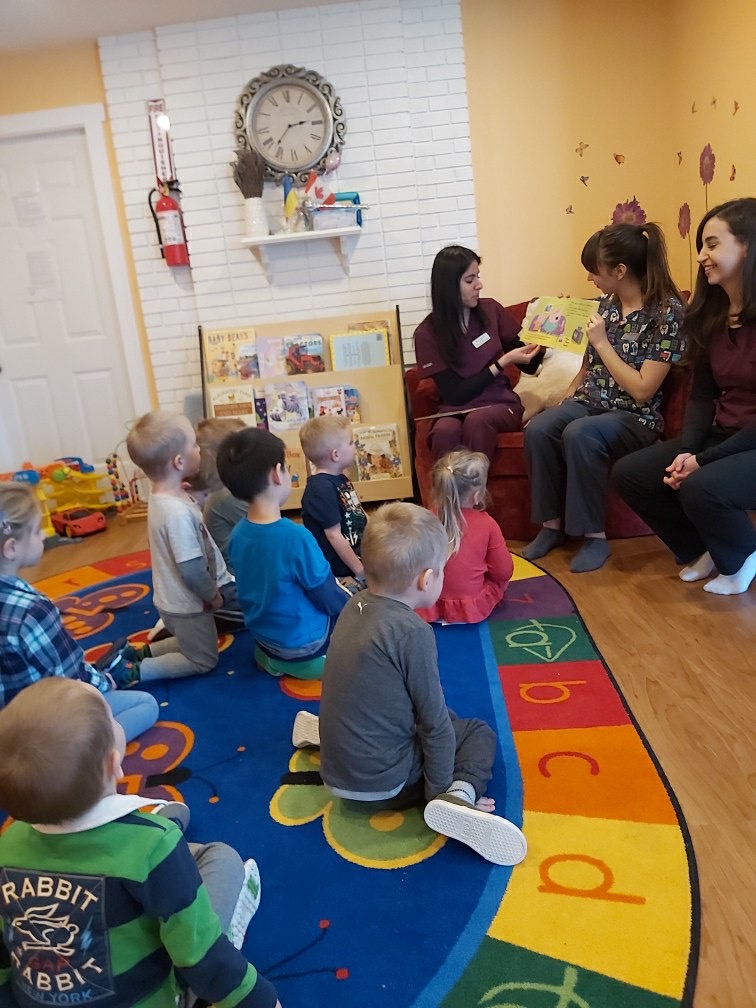DH students adapt presentation to socially-distanced reality
Jessalyn King, Rachelle Pratt - 30 April 2020

Group presents in-person before restrictions kicked in.
Early in the term, fourth-year dental hygiene student groups brainstormed ways to reach out to the community in preparation for National Dental Hygienists Week (NDHW) — an event celebrated annually across Canada in early April as part of Oral Health Month. Students contacted a variety of community organizations, including long-term care facilities, schools, and the Cross Cancer Institute. They wanted to help raise awareness about oral health and increase access to dental-hygiene education activities.
The Dental Hygiene program has a strong community education component, and students demonstrate their knowledge to a variety of audiences. Student Breeanna Gunn said, "We have done presentations to children, newcomers, and individuals living with disabilities throughout our program that we all enjoyed, and we hope to continue giving in-person presentations."
The students had plans for creative information dissemination tactics like games and hands-on demonstrations to go along with poster presentations and Q & A sessions. Marissa Tailleur, who presented to the Terra Centre (support for teenaged parents), said they had interactive components planned such as getting parents to practice brushing their kids' teeth in different positions and choosing nutritious foods, but instead they created a video.
One group of students was able to visit their daycare site just before social distancing measures were put in place. "I feel very lucky that we got an opportunity to present in person," says Anna Lemoine. "I don't think the experience would have been the same through an online platform. Online formats may work for older age groups, but with this age group, they require hands-on activities and constant feedback to grasp concepts."
Other groups got creative and adapted their projects at the last minute, redesigning their activity delivery to accommodate the drastic restrictions on social gatherings. They created digital resources with voice-over or video to allow them to share with the community during NDHW.
Valentine Bedford’s group presented to a third-grade class, and while it took them a couple of tries to adapt their presentation, they were happy with the finished product. They used Google Hangouts, which despite some technical difficulties, worked out okay.
One group filmed the results of an experiment on eggs, demonstrating the effects of various drinks on tooth enamel. This experience emphasized for the students how effective in-person learning experiences are, as compared to videos or remote reading material.
Yet other projects pivoted by shifting their audience to the parents instead of trying to reach the kids directly. "Ideally, the best method to educate this age group is to do fun, interactive activities," said Gunn. "We still used plain language and lots of images to cater to children. However, our presentation would be more useful and engaging if parents sat down with their children to watch."
While many students acknowledged that a video presentation isn't quite the same as engaging in person, students pointed out that with social media, the videos can reach a larger audience, and the communities can keep their videos to play for future members.
Bedford said, "I feel that as dental hygienists, we have options outside working at traditional dental practices, such as working with public health initiatives or with youth. Having experiences like this makes me feel more prepared for working with and educating children."
Lemoine feels that her confidence increased in working with youngsters and that the experience gave her a better understanding of their dexterity at different ages.
The students did a great job adjusting their plans at the last minute. While social distancing measures may be in place for quite some time, this adjustment to the delivery allowed for connection and oral health education despite the COVID crisis. At a time when preventive oral health services are not available to the general population, prevention is crucial.
Instructor Rachelle Pratt said, "The students rallied with positive attitudes, imagination and ingenuity when faced with the abrupt changes. I was very proud that they were able to promote oral health while demonstrating resilience, flexibility and creativity in such unprecedented and uncertain times."